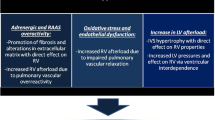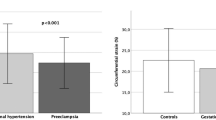Abstract
We aimed to evaluate right ventricular (RV) deformation in recently diagnosed untreated hypertensive patients with different 24-h blood pressure (BP) patterns (dipping, nondipping, extreme dipping and reverse dipping). This cross-sectional study involved 190 untreated hypertensive patients who underwent 24-h ambulatory BP monitoring and a detailed two-dimensional echocardiographic examination, including the assessment of layer-specific strain. We found that 24-h and daytime BP values did not differ between the four groups. Nighttime BP significantly and gradually increased from extreme dippers across dippers and nondippers to reverse dippers. RV structure and systolic and diastolic function did not significantly differ among the four groups. However, RV global and RV free wall longitudinal strains were significantly lower in nondippers and reverse dippers than in dippers and extreme dippers. The endocardial and epicardial RV longitudinal strains of the whole RV and free wall RV were the lowest in reverse dippers and highest in extreme dippers. Multivariate logistic regression analysis demonstrated that only reverse dipping patterns were associated with reduced RV global longitudinal strain [OR 2.9 (95% CI: 1.5–8.2)], independent of age, sex, 24-h systolic BP, LV mass index, RV wall thickness and E/e’t. Similarly, the reverse dipping pattern was associated with reduced RV free wall longitudinal strain, independently of the mentioned parameters [OR 3.8 (95% CI: 1.8–8.5)]. In conclusion, in the hypertensive population, the reverse dipping BP pattern had an adverse effect on RV deformation. RV remodeling progressively deteriorated from extreme dippers to reverse dippers, but only the reverse dipping BP pattern was independently associated with the reduction in RV longitudinal strain.
This is a preview of subscription content, access via your institution
Access options
Subscribe to this journal
Receive 12 print issues and online access
$259.00 per year
only $21.58 per issue
Buy this article
- Purchase on Springer Link
- Instant access to full article PDF
Prices may be subject to local taxes which are calculated during checkout
Similar content being viewed by others
References
Brotman DJ, Davidson MB, Boumitri M, Vidt DG. Impaired diurnal blood pressure variation and all-cause mortality. Am J Hypertens. 2008;21:92–7.
Tsioufis C, Andrikou I, Thomopoulos C, Syrseloudis D, Stergiou G, Stefanadis C. Increased nighttime blood pressure or nondipping profile for prediction of cardiovascular outcomes. J Hum Hypertens. 2011;25:281–93.
Asayama K, Satoh M, Kikuya M. Diurnal blood pressure changes. Hypertens Res. 2018;41:669–78.
Verdecchia P, Angeli F, Mazzotta G, Garofoli M, Ramundo E, Gentile G, et al. Day-night dip and early-morning surge in blood pressure in hypertension: prognostic implications. Hypertension. 2012;60:34–42.
Cuspidi C, Sala C, Tadic M, Rescaldani M, Grassi G, Mancia G. Non-dipping pattern and subclinical cardiac damage in untreated hypertension: a systematic review and meta-analysis of echocardiographic studies. Am J Hypertens. 2015;28:1392–402.
Tadic M, Cuspidi C, Majstorovic A, Sljivic A, Pencic B, Ivanovic B, et al. Does a nondipping pattern influence left ventricular and left atrial mechanics in hypertensive patients? J Hypertens. 2013;31:2438–46.
Cuspidi C, Caffi G, Dell’Oro R, Tadic M, Sala C, Grassi G, et al. Extreme dipping: always means nocturnal hypotension? Am J Hypertens. 2019;32:842–7.
Cuspidi C, Sala C, Tadic M, Gherbesi E, De Giorgi A, Grassi G, et al. Clinical and prognostic significance of a reverse dipping pattern on ambulatory monitoring: An updated review. J Clin Hypertens. 2017;19:713–21.
Ivanovic BA, Tadic MV, Celic VP. To dip or not to dip? The unique relationship between different blood pressure patterns and cardiac function and structure. J Hum Hypertens. 2013;27:62–70.
Tadic M, Cuspidi C, Pencic B, Ivanovic B, Scepanovic R, Marjanovic T, et al. Circadian blood pressure pattern and right ventricular and right atrial mechanics: a two- and three-dimensional echocardiographic study. J Am Soc Hypertens. 2014;8:45–53.
Williams B, Mancia G, Spiering W, Agabiti Rosei E, Azizi M, Burnier M, et al. 2018 ESC/ESH Guidelines for the management of arterial hypertension. The Task Force for the management of arterial hypertension of the European Society of Cardiology and the European Society of Hypertension: The Task Force for the management of arterial hypertension of the European Society of Cardiology and the European Society of Hypertension. Eur Heart J. 2018;36:1953–2041.
Lang RM, Badano LP, Mor-Avi V, Afilalo J, Armstrong A, Ernande L, et al. Recommendations for cardiac chamber quantification by echocardiography in adults: an update from the American Society of Echocardiography and the European association of cardiovascular imaging. J Am Soc Echocardiogr. 2015;28:1–39.
Quinones MA, Otto CM, Stoddard M, Waggoner A, Zoghbi WA. Recommendations for quantification of Doppler echocardiography: a report from the Doppler quantification task force of the nomenclature and standards committee of the American Society of Echocardiography. J Am Soc Echocardiogr. 2002;15:167–84.
Rudski LG, Lai WW, Afilalo J, Hua L, Handschumacher MD, Chandrasekaran K, et al. Guidelines for the echocardiographic assessment of the right heart in adults: a report from the American Society of Echocardiography endorsed by the European Association of Echocardiography, a registered branch of the European Society of Cardiology, and the Canadian Society of Echocardiography. J Am Soc Echocardiogr. 2010;23:685–713.
Buckberg GD, RESTORE Group. The ventricular septum: the lion of right ventricular function, and its impact on right ventricular restoration. Eur J Cardiothorac Surg. 2006;29(Suppl 1):S272–8.
Sarigianni M, Dimitrakopoulos K, Tsapas A. Non-dipping status in arterial hypertension: an overview. Curr Vasc Pharmacol. 2014;12:527–36.
Lisi M, Cameli M, Righini FM, Malandrino A, Tacchini D, Focardi M, et al. RV longitudinal deformation correlates with myocardial fibrosis in patients with end-stage heart failure. JACC Cardiovasc Imaging. 2015;8:514–22.
Cameli M, Sparla S, Focardi M, Righini FM, Solari M, Alvino F, et al. Evaluation of right ventricular function in the management of patients referred for left ventricular assist device therapy. Transpl Proc. 2015;47:2166–8.
Grassi G, Seravalle G, Quarti-Trevano F, Dell’Oro R, Bombelli M, Cuspidi C, et al. Adrenergic, metabolic, and reflex abnormalities in reverse and extreme dipper hypertensives. Hypertension. 2008;52:925–31.
Author information
Authors and Affiliations
Corresponding author
Ethics declarations
Conflict of interest
The authors declare that they have no conflict of interest.
Additional information
Publisher’s note Springer Nature remains neutral with regard to jurisdictional claims in published maps and institutional affiliations.
Rights and permissions
About this article
Cite this article
Tadic, M., Cuspidi, C., Sljivic, A. et al. Do reverse dippers have the highest risk of right ventricular remodeling?. Hypertens Res 43, 213–219 (2020). https://doi.org/10.1038/s41440-019-0351-2
Received:
Revised:
Accepted:
Published:
Issue Date:
DOI: https://doi.org/10.1038/s41440-019-0351-2
Keywords
This article is cited by
-
Non-Dipping Blood Pressure or Nocturnal Hypertension: Does One Matter More?
Current Hypertension Reports (2024)
-
Nocturnal blood pressure patterns and cardiac damage: there is still much to learn
Hypertension Research (2020)



